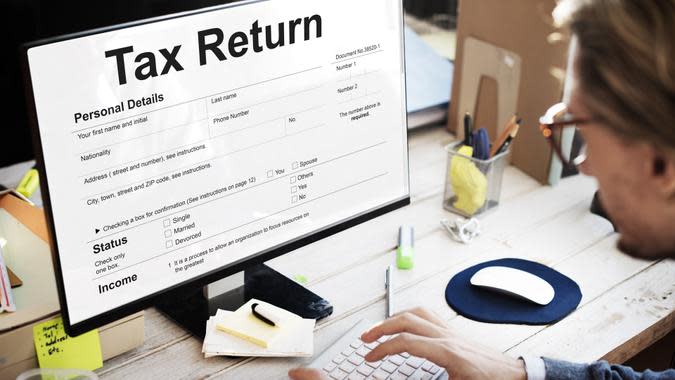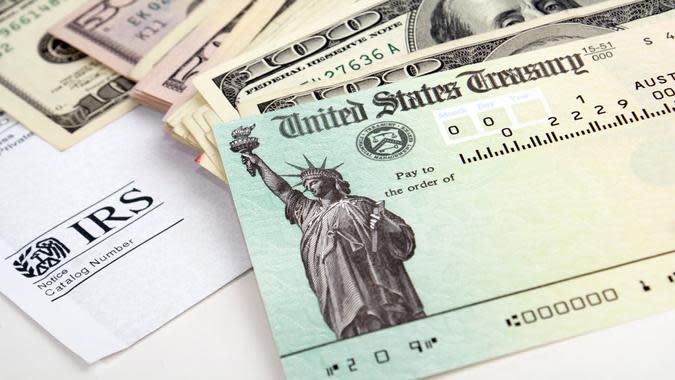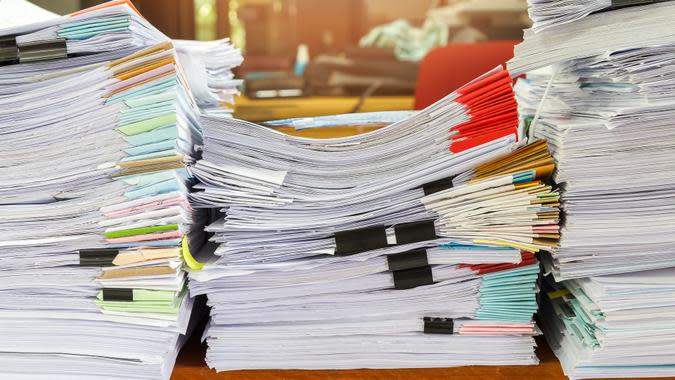Your step-by-step guide to approaching taxes in 2022
Tax season may not be your favorite time of year, but it's a part of life for most income-earning Americans. The process of doing your taxes might seem overwhelming, but if you break it down into easy-to-do steps, it really isn't so bad. Plus, the end result could be extra money in your pocket if you're owed a refund.
Advice: The Best and Worst Things To Buy Generic
Also See: Target, Amazon and 4 More Retailers That Will Reward You for Turning In Your Old Stuff
Whether you're doing your own taxes or using an accountant, these are the steps every tax filer must take in 2022.

1. Figure Out If You Need To File Taxes This Year
Your filing status, age, income and dependency status determine whether or not you need to file taxes, and there are a few reasons you can skip the process altogether. If you are a low-income earner, are 65 or older and don't meet the minimum income thresholds, or you qualify as a dependent, you may not have to file taxes. However, even if you don't have to file taxes, you may still want to if you are eligible to receive the earned income tax credit, the Affordable Care Act premium tax credit or a refund of overpaid taxes from a previous year.If you don't meet these exemptions, or you do, but may get money from the IRS if you file, continue on to the next step.

2. Be Aware of the Key Dates
Make sure you are aware of all the important tax dates for 2022 so you don't miss a deadline. April 18 is the deadline for most individuals to file their 2021 tax returns. April 18 is also the deadline to ask for an extension to file to Oct. 15 — keep in mind that an extension to file is not an extension to pay the taxes you owe.Good Question: Inflation and Your Taxes -- How Do Higher Prices Impact Your Tax Bracket?

3. Gather All of the Necessary Documents
Whether you are doing your own taxes or using a tax preparer, make sure that you have gathered all of the necessary information and documents so that your tax paperwork is accurate. You will need documentation of:Personal information
Dependent information
Work income
Investment income
Distributions from special accounts (retirement income, Social Security income and HSA distributions)
Other income (unemployment benefits, gambling income, distributions from education savings plans, income from sales of property, prior year installment sale information, and business or farming income)
Child care costs
Job-related expenses (only if you are an armed-force reservist, qualified performing artist, fee-basis state or local government official, an employee with impairment-related work expenses or an eligible educator)
Tax preparation costs (only if you are self-employed)
Adoption costs
Educational costs
Healthcare-related records
Charitable contributions
IRA contributions
Real estate property costs
Deductible taxes
Federal disaster area provisions
Other information (estimated tax payments you made during the year, prior year's refund applied to the current year and any amount you paid in connection with a filing extension; and foreign bank account information)

4. Decide How You Will Be Filing Taxes
If you will be using a tax preparer, make an appointment sooner rather than later, as they tend to get busy closer to the deadline.If you are doing your own taxes, figure out how you will be filing (via mail or online), and if you will be using any tax software or apps to help you through the process. If you make $73,000 or less a year, you can file for free via the IRS Free File Program.

5. Determine If You Owe Money to the IRS — Or If You Are Owed Money
When you complete your tax forms, you will see the difference between the amount of taxes you paid for the year and the amount of taxes you owed for the year. If you owe money to the IRS, you generally need to submit the payment along with the filing. If you cannot pay your taxes in full, you may be able to request a payment plan to make payments in installments.If you are owed money from the IRS, you will receive it in the form of a refund. Direct deposit is the quickest and easiest way to receive your refund, so be sure to fill out your bank account information if you qualify for money back.Explore: How To Invest Your Tax Refund and Other Financial Windfalls Wisely This Year

6. Double-Check All of Your Forms Before Submitting
Whether you are submitting your taxes yourself or filing through an accountant, double-check all forms for accuracy before submitting them to the IRS. Make sure all numbers are correct — this includes income, expenses, Social Security numbers and ID numbers for you and your dependents. A simple mistake or a typo can lead to delays in the IRS processing your return.Once you've determined that your return is accurate, submit it to the IRS (or have your tax professional submit it on your behalf).

7. Hold Onto All of Your Paperwork
Once you've submitted your tax return, you may be tempted to throw out all of the paperwork — but you need to hold onto your tax records for at least three years. Having all of your documents safely filed away will ensure that you can defend yourself if you do end up getting audited by the IRS.More From GOBankingRatesFood Stamps: Can You Use Your SNAP EBT Card at Gas Stations?
30 Biggest Do's and Don'ts When Buying a Car
How to Easily Add $500 to Your Wallet This Month
35 Useless Expenses You Need To Slash From Your Budget Now
This article originally appeared on GOBankingRates.com: Your Step-by-Step Guide To Approaching Taxes in 2022
